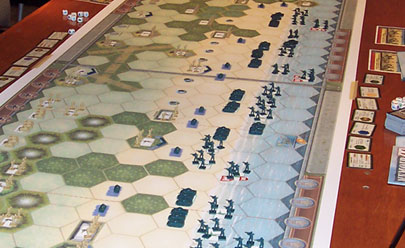CHOOSING WARGAMES:

Wargaming for Educational Purposes — Electronic, Board or Miniatures
The National WWII Museum focuses on board or miniatures games, rather than electronic wargames. We do this for several reasons listed below.
Development of social skills.
Board and miniature wargame players sit across from each other. They see each other and directly interact. Large games involving teams promotes team building, management skills and resource management in a cooperative environment. In recreating difficult military situations, players vicariously gain glory in victory, or suffer dismal defeat in the social setting of the group. As they do so, they develop real human friendships. Game friendships, formed through sharing the hobby, can last a lifetime. Unless playing with someone in the next chair through a shared network, electronic games only provide a limited comradeship through disembodied voices, though possibly from across the globe.
Development of critical and strategic thinking.
In most board and miniatures games, as in life, players must generate a workable strategic plan to be successful. Games encourage consideration of future challenges, and the best responses, before those challenges occur. In many electronic games, advance planning may not be feasible, as game challenges may remain unknown — and the mission may only involve a body count.
Game scales and probability can be misrepresented in electronic games. Board and miniatures games generally let you know — in advance — the probability of various occurrences in the wargame and put the probability in your hand in the form of dice. Math skills are reinforced by the player’s personal game calculations. This makes the board or miniatures wargame a better historical educational tool. In electronic gaming, computers handle all calculations and probability is located in the device’s random number generator. The player has no idea how easy or hard a function is, unless they reboot to play multiple sessions.
Accuracy.
Electronic first-person shooter games often immerse the player in an exciting, ongoing environment, but single person e-games often provide little understanding of the risks involved beyond the player’s role. The role of leadership can be misconstrued. However, it is true that electronic first-person shooter games more accurately portray the often horrific violence of war. This is abstracted in board and miniatures games, but those do a better job of educating players as to the larger scope of battle. This debate has informed The National WWII Museum’s educational wargame choices; as an institution, we hope to introduce youth to a critical time in world history. We also recognize the desire to involve parents in gaming.
All wargames sacrifice realism for playability, the question is how much — and whether it is acknowledged by the game developers. If a gameplay situation seems questionable in light of reality, it probably is. Learn more and come to your own determination about the accuracy of that game and the reality of that battle.
Development of creativity.
In miniature games, hobbyists often research the military units they are using, and often try to replicate the paint scheme of the real military unit. They must also analyze (and, in miniature games, build) the map, the roads, hills and other historical terrain fought over. Books, magazines, multimedia and interviews are all used in the discovery process. This process requires patience and creativity — and makes for a better learning experience. It also provides a more complete, and thus more interesting, panoramic overview of the battlefield. Electronic games are constrained by the scenarios and responses programmed into them, thus they generally offer low replay value. Board and miniatures games played against human opponents allow for the creative flexibility of the human mind.
To learn more or receive notices about historical wargaming at The National WWII Museum, contact walt.burgoyne@nationalww2museum.org or call (504) 528-1944 x 333. Or sign up for Educational WWII Wargaming eNews.


